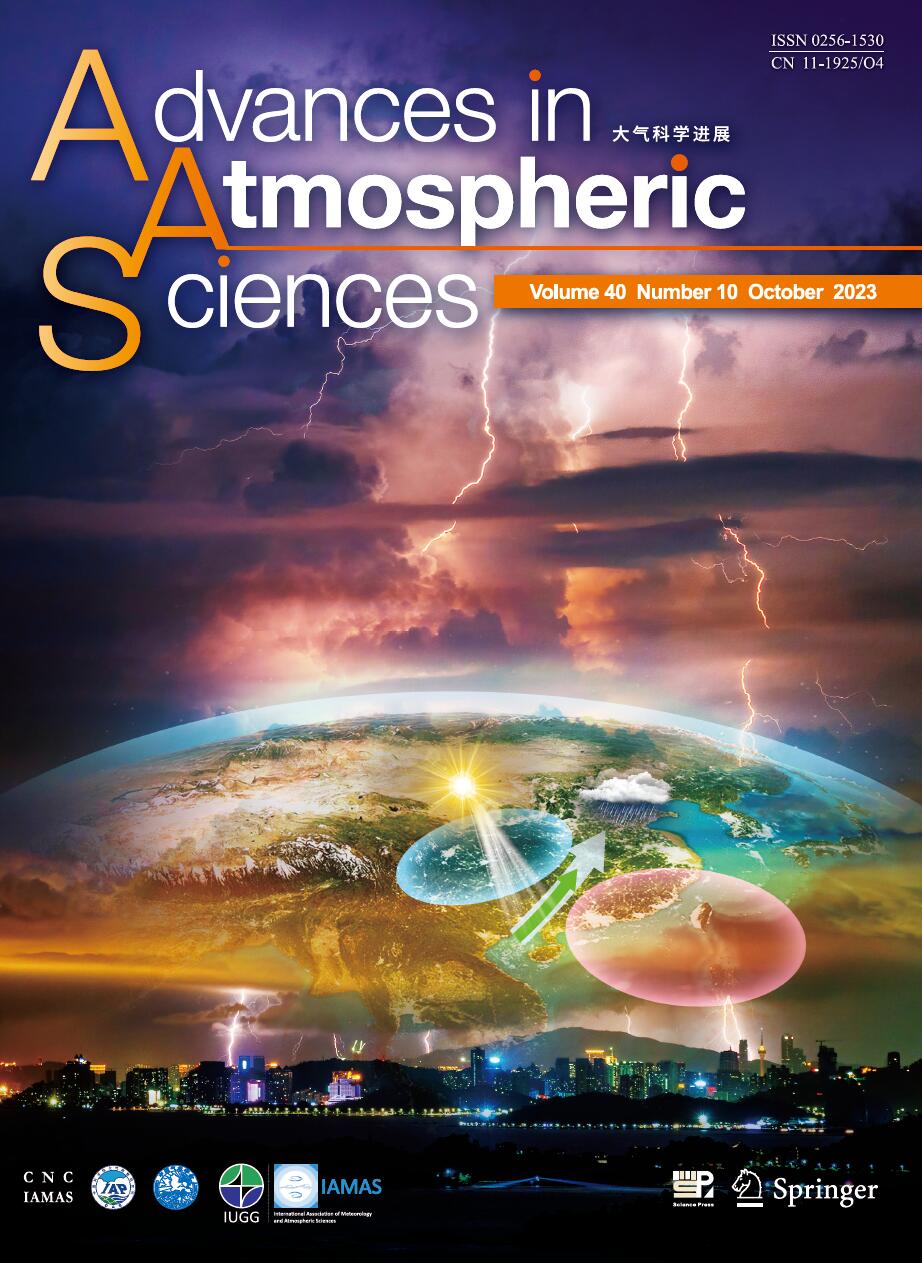| [1] |
ZHANG Dingyuan, LIAO Hong, WANG Yuesi,
2014: Simulated Spatial Distribution and Seasonal Variation of Atmospheric Methane over China: Contributions from Key Sources, ADVANCES IN ATMOSPHERIC SCIENCES, 31, 283-292.
doi: 10.1007/s00376-013-3018-y
|
| [2] |
LI Jiawei, HAN Zhiwei,
2012: A Modeling Study of Seasonal Variation of Atmospheric Aerosols over East Asia, ADVANCES IN ATMOSPHERIC SCIENCES, 29, 101-117.
doi: 10.1007/s00376-011-0234-1
|
| [3] |
KUANG Xueyuan, ZHANG Yaocun,
2005: Seasonal Variation of the East Asian Subtropical Westerly Jet and Its Association with the Heating Field over East Asia, ADVANCES IN ATMOSPHERIC SCIENCES, 22, 831-840.
doi: 10.1007/BF02918683
|
| [4] |
LIU Xiangcui, LIU Hailong,
2014: Heat Budget of the South-Central Equatorial Pacific in CMIP3 Models, ADVANCES IN ATMOSPHERIC SCIENCES, 31, 669-680.
doi: 10.1007/s00376-013-2299-5
|
| [5] |
HU Ruijin, LIU Qinyu, MENG Xiangfeng, J. Stuart GODFREY,
2005: On the Mechanism of the Seasonal Variability of SST in the Tropical Indian Ocean, ADVANCES IN ATMOSPHERIC SCIENCES, 22, 451-462.
doi: 10.1007/BF02918758
|
| [6] |
LI Wei, CHEN Longxun,
2003: Characteristics of the Seasonal Variation of the Surface Total Heating over the Tibetan Plateau and Its Surrounding Area in Summer 1998 and Its Relationship with the Convection over the Subtropical Area of the Western Pacific, ADVANCES IN ATMOSPHERIC SCIENCES, 20, 343-348.
doi: 10.1007/BF02690792
|
| [7] |
Jinghua CHEN, Xiaoqing WU, Chunsong LU, Yan YIN,
2022: Seasonal and Diurnal Variations of Cloud Systems over the Eastern Tibetan Plateau and East China: A Cloud-resolving Model Study, ADVANCES IN ATMOSPHERIC SCIENCES, 39, 1034-1049.
doi: 10.1007/s00376-021-0391-9
|
| [8] |
Xiuzhen LI, Wen ZHOU, Yongqin David CHEN,
2016: Detecting the Origins of Moisture over Southeast China: Seasonal Variation and Heavy Rainfall, ADVANCES IN ATMOSPHERIC SCIENCES, 33, 319-329.
doi: 10.1007/s00376-015-4197-5
|
| [9] |
Xinyi XING, Xianghui FANG, Da PANG, Chaopeng JI,
2024: Seasonal Variation of the Sea Surface Temperature Growth Rate of ENSO, ADVANCES IN ATMOSPHERIC SCIENCES, 41, 465-477.
doi: 10.1007/s00376-023-3005-x
|
| [10] |
Pratima GUPTA, Shalendra Pratap SINGH, Ashok JANGID, Ranjit KUMAR,
2017: Characterization of Black Carbon in the Ambient Air of Agra, India: Seasonal Variation and Meteorological Influence, ADVANCES IN ATMOSPHERIC SCIENCES, 34, 1082-1094.
doi: 10.1007/s00376-017-6234-z
|
| [11] |
LI Qiang, ZHANG Renhe,
2012: Seasonal Variation of Climatological Bypassing Flows around the Tibetan Plateau, ADVANCES IN ATMOSPHERIC SCIENCES, 29, 1100-1110.
doi: 10.1007/s00376-012-1154-4
|
| [12] |
Peng Yongqing, Yan Shaojin,
1994: Seasonal Variation Features of Western North Pacific Tropical Cyclone Tracks with Their Predictability, ADVANCES IN ATMOSPHERIC SCIENCES, 11, 463-469.
doi: 10.1007/BF02658167
|
| [13] |
Liu Xuanfei, Zhu Qiangen, Guo Pinwen,
2000: Conversion Characteristics between Barotropic and Baroclinic Circulations of the SAH in Its Seasonal Evolution, ADVANCES IN ATMOSPHERIC SCIENCES, 17, 129-139.
doi: 10.1007/s00376-000-0049-y
|
| [14] |
Long WEN, Kun ZHAO, Mengyao WANG, Guifu ZHANG,
2019: Seasonal Variations of Observed Raindrop Size Distribution in East China, ADVANCES IN ATMOSPHERIC SCIENCES, 36, 346-362.
doi: 10.1007/s00376-018-8107-5
|
| [15] |
ZHANG Xinping, LIU Jingmiao, HE Yuanqing, TIAN Lide, YAO Tandong,
2005: Humidity Effect and Its Influence on the Seasonal Distribution of Precipitation δ18O in Monsoon Regions, ADVANCES IN ATMOSPHERIC SCIENCES, 22, 271-277.
doi: 10.1007/BF02918516
|
| [16] |
WANG Zaizhi, WU Guoxiong, WU Tongwen, YU Rucong,
2004: Simulation of Asian Monsoon Seasonal Variations with Climate Model R42L9/LASG, ADVANCES IN ATMOSPHERIC SCIENCES, 21, 879-889.
doi: 10.1007/BF02915590
|
| [17] |
Qian Weihong, Zhu Yafen, Xie An, Ye Qian,
1998: Seasonal and Interannual Variations of Upper Tropospheric Water Vapor Band Brightness Temperature over the Global Monsoon Regions, ADVANCES IN ATMOSPHERIC SCIENCES, 15, 337-345.
doi: 10.1007/s00376-998-0005-9
|
| [18] |
HUANG Ying, QIAN Yongfu,
2007: Analysis of the Simulated Climatic Characters of the South Asia High with a Flexible Coupled Ocean--Atmosphere GCM, ADVANCES IN ATMOSPHERIC SCIENCES, 24, 136-146.
doi: 10.1007/s00376-007-0136-4
|
| [19] |
Zuohao CAO, Ronald E.STEWART, M.K.YAU,
2004: A New Perspective of the Physical Processes Associated with the Clear-Sky Greenhouse Effect over High Latitudes, ADVANCES IN ATMOSPHERIC SCIENCES, 21, 171-180.
doi: 10.1007/BF02915703
|
| [20] |
Wang Huijun, Xue Feng, Zhou Guangqing,
2002: The Spring Monsoon in South China and Its Relationship to Large-Scale Circulation Features, ADVANCES IN ATMOSPHERIC SCIENCES, 19, 651-664.
doi: 10.1007/s00376-002-0005-0
|















 AAS Website
AAS Website 
 AAS WeChat
AAS WeChat 
 DownLoad:
DownLoad: